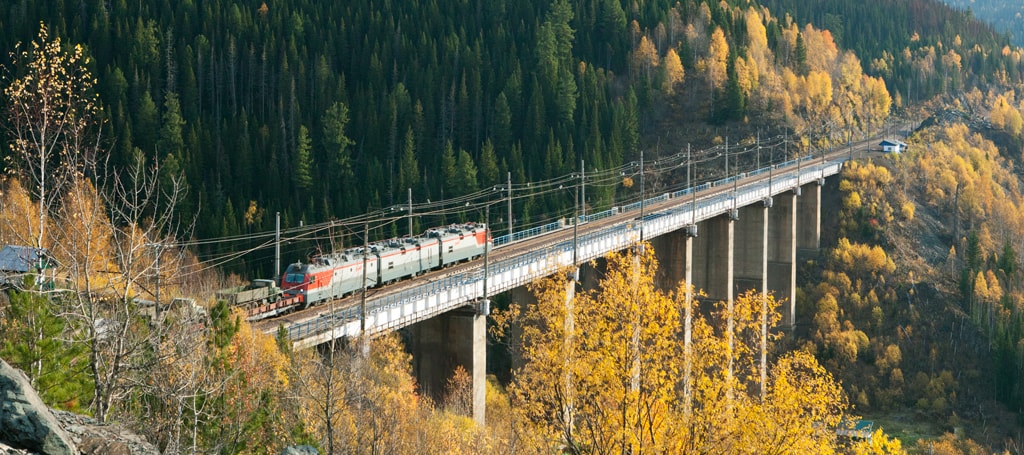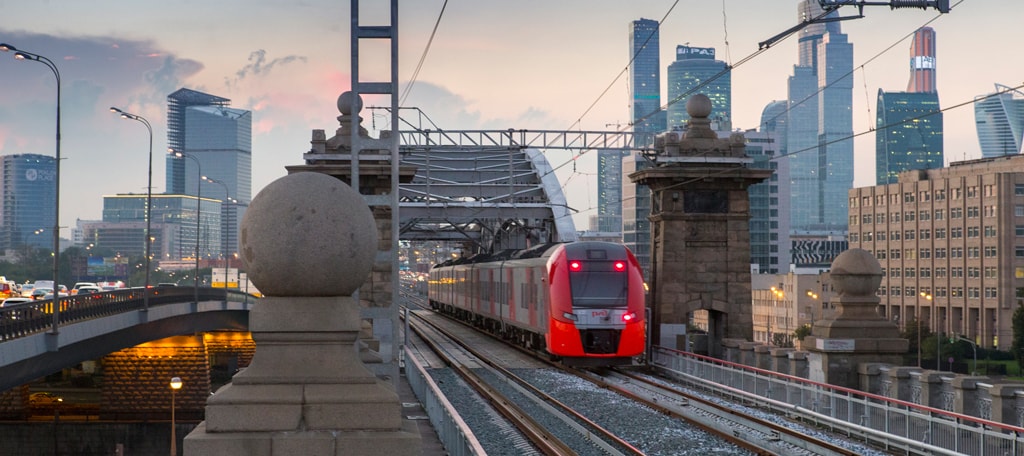Implementation of projects with government support
Modernisation of the railway infrastructure of the Baikal-Amur and Trans-Siberian Mainlines
In an effort to eliminate bottlenecks on the railways of the Baikal region and the Far East to ensure up to 66.8 mln tonnes of additional freight transportation per year for Russian companies by 2020 compared with the 2012 level, a set of priority measures has been implemented since 2013 to develop the railway infrastructure of the Eastern operating domain.
The following has been put into permanent operation on Eastern operating domain facilities as part of the implementation of the project in 2016:
- additional main tracks built on the Taksimo – Lodya stretch (27.7 km);
- reconstruction of 9 stations – 92.2 km (Khabarovsk Park B, Uktur, Pozharsky, Teysin, Vandan, Komsomolsk – Marshalling, Slyudyanka-2, Izvestkovaya) and 11 passing loops (323 km, Mokhortov, Barsovy, Duki, Pil, Talidzhak, Badzhal, Kholoni, Katama, Dalnevostochny, Sagdzhemu);
- renovation of 34.7 km of automatic blocking;
- reconstruction of the road bed on 5 sections (Ogoron – Moldavsky (2,782 km PK0 – 2,783 km PK4), Tangomen – Dugda (2,893 km PK0 – 2,894 km PK2), Dugda – Nora (2,904 km PK5 – 2,906 km PK6);
- Khabarovsk – Ussuriysk (8,961 km), Turinskaya – Karymskaya (6,278 km);
- modernisation of 18 traction substations (Khilok, Gonzha, Mogzon, Razmakhino, Urulga, Ayachi, Amazar, Lesnaya, Koroli, Tarmanchukan, Priiskovaya, Ruzhino, Sibirtsevo, Sokhondo, Yanchukan, Daban, Ulkan, Kunerma);
- reconstruction of 11 small bridges and a bridge over Bureya River;
- construction of 10 residential buildings (at the stations Novaya Chara, Oktyabrsky, Taksimo, Vikhorevka, Magdagachi, Litovko and Obluchye).

Comprehensive development of the Mezhdurechensk – Tayshet section
This project is being implemented to handle the projected freight flow by 2020, above all to ensure freight transportation of 15 mln tonnes on the Kyzyl – Kuragino railway line currently under construction by 2020, including the shipment of 12 mln tonnes of coal from the Elegestkoye coal deposit to Far East ports.
The project envisages a full set of measures to increase the section’s capacity: the construction of 115 km of additional main tracks, 2 passing loops, the new Avda – Gromadskaya connecting line with a signalling, centralisation and blocking device, the reconstruction of the second Dzhebsky Tunnel, the development of stations, the reinforcement of power supply devices on the Abakan – Kuragino, Kuragino – Sayanskaya and Uyar – Tayshet sections.
The following facilities have been put into operation as of 1 January 2017:
- the Kirba passing loop on the Khankul – Khonykh stretch;
- downyard shunting at the Abakan station;
- Avda – Gromadskaya connecting line (3.3 km); Avda – Gromadskaya connecting line (3.3 km);
- first stage of the construction of secondary tracks on the Lukashevich – Kravchenko stretch (1.5 km).
Development and renovation of railway infrastructure at approaches to ports in the Azov and Black Seas
In 2016, work was fully completed on the construction of 22.3 km of additional main tracks on the Abganerovo(included in reconstruction)–Gniloaksayskaya (excluded from reconstruction) haul. The opening of the section was delayed until 2017 due to the lengthy registration of permit and title documents.
In addition, the following work was continued:
- the construction of additional main tracks with total length of 131.3 km, including on the stretches: Tinguta – Abganerovo (21.5 km), Remontnaya – Gashun (20.1 km), Gashun – Zimovniki (17.6 km), Manych – Shablievskaya (7.4 km), Zabyty – Polivyansky (17.7 km), Razvilnaya – Peschanokopskaya (18.5 km), Poroshinskaya – 4 km (17.5 km) and Poltavskaya – Protoka (11 km);
- the reconstruction of the Kozyrki station and the construction of the Grechanaya station as well as the completion of preparatory work on the construction of the Krasnodar hub bypass on the Grechanaya – Kozyrki section.
Design and survey work was performed for the construction of additional main tracks on the stretches: Gornopolyansky – Kanalnaya, Kanalnaya – Tinguta, Eya – Rovnoye, Rovnoye – Poroshinskaya and others, as well as the Krasnodar hub bypass and the construction of road overpasses on the sections.
The following work was performed in 2016:
- backfill of the road bed – 1,130,000 m3;
- laying of 81.0 km of tracks and 51 sets of turnouts;
- track ballasting – 270,000 m3;
- construction of engineering structures – 21 construсtion pipes;
- construction of 13 bridges;
- reconstruction of 5 crossings;
- installation of protective screens – 2.2 km; installation of protective screens – 2.2 km;
- installation of 1,700 contact network supports;
- installation of 67 km of contact suspension.
Development of the railway infrastructure of the Moscow Transport Hub
As part of the implementation of the Programme for the Implementation of a Comprehensive Project for the Development of the Railway Infrastructure of the Moscow Transport Hub in 2012–2020 and until 2025 (hereinafter the Programme), Russian Railways completed construction work in 2016 as part of the Reconstruction and Development of the Moscow Little Ring Railway project.
The start of regular passenger transportation on the Moscow Central Ring (hereinafter the MCR) was a landmark for the Moscow region.
The implementation of the project established a modern urban passenger transportation system, eased the burden on the metro system and land transportation, created a new interchange loop and improved the transportation accessibility throughout the city. The modernisation of railway infrastructure made it possible to connect residential areas, parks, sports facilities, shopping centres and offices, and ensure the development of depressed parts of the city that had previously been inaccessible. The surrounding urban areas have been given a new impetus for development.
A total of 27 mln passengers were transported in 2016, and passenger traffic continues to grow. The need to further develop the MCR has already been identified: increase throughput and carrying capacity, reduce train intervals and, as a consequence, develop passenger and railway infrastructure.
Construction and installation work was also completed in 2016 to build passenger infrastructure at the Otdykh halt platform on the Kazakh railway in order to establish an additional stop for Sputnik electric trains to ensure transport accessibility to the National Aviation Centre (NAC). A stop for Sputnik electric trains travelling on the Moscow – Ramenskoye route was organised on 12 September 2016.
In addition, work was performed as part of projects to develop railway infrastructure on the following radial routes – Paveletsky, Yaroslavl, Gorkov, Kursk and Smolensk.
Construction of the Prokhorovka – Zhuravka – Chertkovo – Bataysk railway line
The main goal of the project to build a 136.9-km railway on the Zhuravka – Millerovo section to bypass Ukrainian territory is to improve the safety of freight and passenger transportation and ensure stable transportation towards the south that does not depend on external factors.
The work is being performed pursuant to Decree No. 196 of the President of the Russian Federation dated 17 April 2015 ‘On the Construction of a Two-Track Electrified Railway on the Zhuravka – Millerovo Section’.
As of 1 January 2017, the following design, construction and installation work had been performed:
- all high-voltage power transmission lines (12 intersections) were fully removed from the construction zone;
- the communications lines of Rostelecom were fully reorganised;
- work was completed on the rerouting of 8 of 11 gas pipelines (73%);
- a large portion of engineering structures were built – 70 of 98 under the project (71%), including 66 culverts (100%), 2 small cattle-crossing bridges (100%) and 2 of 19 railway overpasses (10%);
- the backfill of 34.3 mln m3 of road bed of a total 40.4 mln m3 (86%). The road bed is scheduled to be fully completed in January 2017 by the deadline specified in the action plan.
Work is being conducted to build the track superstructure and electrification line.
A total of 40.2 km of track superstructure sections have been laid, including on the Zhuravka – Zaytsevka and Zaytsevka – Sergeyevka stretches – 23.7 km of main tracks, and at the Zhuravka, Zaytsevka and Sergeyevka stations – 16.5 km.
As regards design work, favourable conclusions on state expert evaluations were obtained for the design and estimate documentation for four of eight stages of the facility, while design documentation for another four stages is currently undergoing a state expert evaluation with the Russian Main State Expert Review Board.

Construction of the Moscow – Kazan High-Speed Railway
Systematic preparations were made in 2016 to build the first Russian-made high-speed railway pursuant to the instructions of the country's leadership and in accordance with the network schedule for implementing the Moscow – Kazan High-Speed Railway approved by Order No. 5-r of the Government of the Russian Federation dated 13 January 2016.
Jointly with High-Speed Railways, a Russian-Chinese consortium of design organisations and French technical consultants (Systra, SNCF), Russian Railways has fully completed a set of engineering surveys and drafted design documentation for the construction for the first section of the Moscow – Nizhny Novgorod railway.
Documentation has been drafted and approved by the Russian Ministry of Construction to configure the territory for the construction of railways in the Moscow, Vladimir and Nizhny Novgorod Regions.
Documentation for the construction of railways in Moscow, Mari El Republic, Chuvash Republic and the Republic of Tatarstan has been submitted to the ministry for endorsement and approval.
In 2016, a concept was drafted to develop the territories surrounding the HSR, and data sheets were compiled for investment projects identifying the main areas and parameters for developing the territories.
A public technological and price audit of engineering surveys and design documentation for the Moscow – Nizhny Novgorod section was carried out, including an assessment of the technical requirements, limitations of high-speed rolling stock and its operation and maintenance technologies taking into account the proposed design solutions, which resulted in a favourable conclusion.